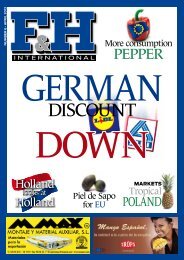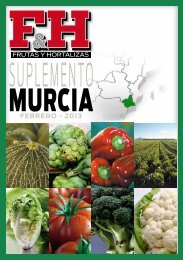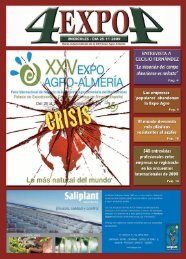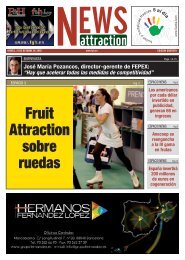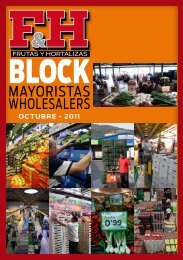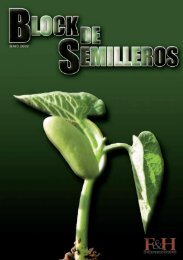Reporting On... - Revista F&H
Reporting On... - Revista F&H
Reporting On... - Revista F&H
You also want an ePaper? Increase the reach of your titles
YUMPU automatically turns print PDFs into web optimized ePapers that Google loves.
6<br />
Spanish peppers:<br />
under close observation<br />
Belgian lettuce: scores badly<br />
GERMAN RETAIL CHAIN REWE’S<br />
2010 REPORT ON RESIDUES IN<br />
CONVENTIONALLy-GROWN FRUIT<br />
AND VEGETABLES PAINTS A HOPEFUL<br />
PICTURE OF THE FRESH PRODUCE ON<br />
THE MARKET BUT ALSO POINTS OUT<br />
WHAT REMAINS TO BE DONE.<br />
By Uwe Schwießelmann<br />
uwe@fyh.es<br />
The report, commissioned<br />
by Rewe and elaborated and<br />
drawn up by the Austrian<br />
environmental organization<br />
GLOBAL 2000, interprets the<br />
results of over 7,250 analyses<br />
(of over 100 different fruits<br />
and vegetables from 61 countries<br />
of origin) and has been<br />
published last August.<br />
The enormous amount of<br />
data gathered in the report<br />
show that for the last few<br />
years the general situation<br />
regarding pesticide residues<br />
F&H International 1 • November 2011 Focal Point<br />
has been constantly improving<br />
with respect to both acute<br />
and chronic health risks.<br />
The calculation of the former<br />
was based on the WHO values<br />
of the ARfD (Acute Reference<br />
Dose): For all products<br />
included in the report, the<br />
percentage of samples that<br />
exceed the ARfD has been<br />
constantly sinking from 1.71<br />
per cent in 2007 to 0.21 per<br />
cent in 2010. To measure<br />
the chronic health risks, socalled<br />
“PRP” limits (significantly<br />
lower than the legal<br />
residue limits) were established:<br />
the ADI (Acceptable<br />
Daily Intake; mg per kilogramm<br />
body weight) multiplied<br />
by 13.5.<br />
The contamination level (CL)<br />
of a sample was indicated by<br />
the percentage of the concentration<br />
found in proportion<br />
to the corresponding PRP<br />
value; multiple residues (several<br />
agents per sample) were<br />
accounted for by adding the<br />
respective percentages.<br />
Decrease CL. Over the last<br />
years, the average CL for<br />
all analyzed fruits and vegetables<br />
has decreased from<br />
117% in 2007 to 58% in<br />
2010. A closer look at particular<br />
product groups shows,<br />
for example, that the CL of<br />
cherries, 42% in 2010, was<br />
an amazing 740% just one<br />
year before; the contamination<br />
level of peaches has been<br />
permanently going down<br />
from 130 per cent in 2007 to<br />
58 per cent three years later; a<br />
similar evolution has been re-<br />
corded for cucumbers (from<br />
53% to 19%); apples (36%)<br />
and tomatoes (31%), too,<br />
have improved with regard<br />
to their CL values of 2009, 60<br />
and 45 per cent, respectively.<br />
However, it’s not all beer and<br />
skittles. For example, there<br />
is a 2009-2010 increase in<br />
the CL values of all citrus<br />
subgroups, except lemons.<br />
The same is true for pears.<br />
Peaches may have a lower<br />
CL than ever, but they also<br />
are the product group with<br />
the highest incidence when it<br />
comes to residues that exceed<br />
the ARfD: 1.6%, the highest<br />
value since 2007. And even<br />
though the product groups<br />
without any residues above<br />
the ARfD have gone up to 22<br />
(of 30), 1.57% of grapefruit,<br />
pomelos or limettas, 1.26<br />
per cent of all lemons, and<br />
0.7% of oranges we consume<br />
are still considered an acute<br />
health risk. And then there is<br />
Belgian lettuce … (s. above).




